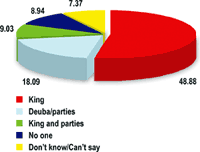 King Prithibi Narayan Shah stood on Chandragiri Pass in 1768 and looked down at the prosperous and fertile valley called Nepal. The kingdom he unified became synonymous with its new capital.
King Prithibi Narayan Shah stood on Chandragiri Pass in 1768 and looked down at the prosperous and fertile valley called Nepal. The kingdom he unified became synonymous with its new capital.
Today, Maoists rebels are on the Valley rim and are also looking down at the capital, coveting the prize that is Kathmandu. The Valley's attraction as the political and economic epicentre of the country has been augmented by the relative security it provides to the hundreds of thousands of internally displaced fleeing the insurgency.
Nepal is more Kathmanducentric today than it ever was: the only international airport is here and it is the industrial and cultural hub. The Valley's population has doubled to 2 million since 1990 and nearly one in every 10 Nepalis now lives here. Being a power centre, Kathmandu is a status quo metropolis. The country's conflict has focussed the attention of the political parties, the insurgents, the king and his subjects on the capital. All of them think that Nepal's problems can be fixed if Kathmandu can be fixed. 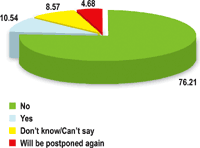 The anti-'regression' protests are not just centred in Kathmandu, but in the centre of Kathmandu at Ratna Park. The Maoists may claim that they hold sway over three-quarters of the country, but they are reserving their 'decisive and final blow' for the Valley.
The anti-'regression' protests are not just centred in Kathmandu, but in the centre of Kathmandu at Ratna Park. The Maoists may claim that they hold sway over three-quarters of the country, but they are reserving their 'decisive and final blow' for the Valley.
Kathmandu's centrality prompted Himalmedia to conduct its annual public opinion poll in the capital this year to gauge how its residents assess the country's situation. Who do they blame? Who do they think should be responsible for finding a solution? 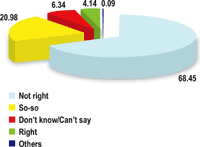 They seem to have no doubt that things are a mess. More than three-quarters of the respondents feel the country's situation is either 'bad' or 'frightening'. And who do they blame for it? Eighteen percent blame the Maoists, 16 percent blame corruption, and 12.5 percent feel the king is responsible. The Nepali Congress is close behind, with 11.3 percent blaming it for the country's situation while only seven percent feel the UML is responsible.
They seem to have no doubt that things are a mess. More than three-quarters of the respondents feel the country's situation is either 'bad' or 'frightening'. And who do they blame for it? Eighteen percent blame the Maoists, 16 percent blame corruption, and 12.5 percent feel the king is responsible. The Nepali Congress is close behind, with 11.3 percent blaming it for the country's situation while only seven percent feel the UML is responsible.
Asked who they think is really in charge, nearly half the respondents are convinced the king is. Only 19 percent feel Sher Bahadur Deuba is in control, while nine percent think the country is actually leaderless. 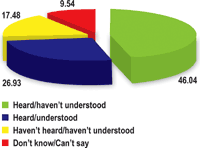 More than half the respondents feel the king's October Fourth move to sack the prime minister was wrong or unconstitutional and a little over a quarter think it was right and timely. And nearly 75 percent of Kathmanduites think the insurgency has become worse since King Gyanendra took over, 18 percent think it is the same, and only 3.5 percent feel the situation has got better in the past two years.
More than half the respondents feel the king's October Fourth move to sack the prime minister was wrong or unconstitutional and a little over a quarter think it was right and timely. And nearly 75 percent of Kathmanduites think the insurgency has become worse since King Gyanendra took over, 18 percent think it is the same, and only 3.5 percent feel the situation has got better in the past two years.
Since most respondents feel the king has been responsible for the deepening crisis in the country, in response to another question nearly, 70 percent think the king can set things right if he wants to. Forty-five percent think the king should talk directly to the Maoists and end the stalemate.
Eleven percent of Kathmanduites are convinced the king should rule directly, and this is the same segment that supported his October Fourth move. Nearly 41 percent think the crisis can be resolved if the political parties unite,
and 32 percent see a role for the king. 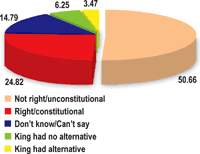 Asked what they think about the Maoist insurgency, nearly 70 percent think it is wrong, while 25 percent have a positive attitude towards it. Asked how the crisis can be resolved, 36 percent answered that it must be through negotiations, 13 are in favour of a constituent assembly and 12 percent think it will only happen if the Maoists give up arms.
Asked what they think about the Maoist insurgency, nearly 70 percent think it is wrong, while 25 percent have a positive attitude towards it. Asked how the crisis can be resolved, 36 percent answered that it must be through negotiations, 13 are in favour of a constituent assembly and 12 percent think it will only happen if the Maoists give up arms.
In comparison to Himalmedia polls in previous years, there has been a dramatic shift of blame away from the political parties towards the king and the Maoists, possibly because respondents now feel the parties are out of the picture. The people believe the palace and the rebels are trying to sideline the parties. Still, they don't yet see the insurgency as more serious than, for instance, the water and pollution problems in the Valley. The blockade may have brought the war nearer, but for Kathmandu's inhabitants, everyday concerns still dominate.
Social scientists have long wondered why cities don't breed revolutions. Samuel Huntington in his 1968 book Political Order in Changing Societies asks: 'Why don't we get revolutionaries in cities? Why don't they revolt even though there are huge economic and social problems?' It is true: slum dwellers in Bombay, people living in shantytowns in Chile and the migrant colonies in Lima may wallow in squalour, but they don't revolt.
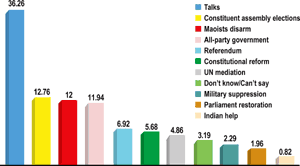 In fact, John Walton in his 1987 book The Capitalist City notes that cities have riots, not revolts. The street unrest in Kathmandu in the past few years proves the point: they had anarchistic traits rather than political ones. Despite infiltration, the riots never took on political character to escalate into mass urban uprisings.
In fact, John Walton in his 1987 book The Capitalist City notes that cities have riots, not revolts. The street unrest in Kathmandu in the past few years proves the point: they had anarchistic traits rather than political ones. Despite infiltration, the riots never took on political character to escalate into mass urban uprisings.
Like all capitals, the geopolitical, cultural, economic and religio-historical character of this city makes it a conservative, status quo town. But now there is pressure for change. The traditional power centres may find security in historical rites and certainties, but these will not suffice in facing the challenges of modern Nepal.
And this contradiction and bewilderment is reflected in this year's public opinion poll of the Valley.
Polling method and respondents
A random sample of 3,312 respondents was conducted by experienced enumerators from 26 September-1 October. Valley residents were selected in urban and suburban areas and weighted for socio-economic, gender and geographic balance. Of the total, nearly 60 percent were men, 40 percent were women and the sample was predominantly Hindu (85 percent). Only 10 percent were illiterate, four percent unemployed, 11 percent vegetarian.
Nearly half those interviewed were from Kathmandu, 25 percent had moved here in the past five years and 20 percent in the past 15 years, providing some indication of the intense urbanisation of Kathmandu Valley since 1990.The foremost problem for Valley residents seems to be water, followed closely by pollution. Full details and analysis of the poll conducted by Rajendra Dahal and Navin Subedi for Himalmedia is posted at www.nepalihimal.com


